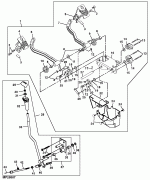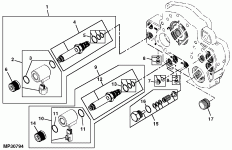again chickenman,check those connections ! i don't know what the actual values of the potentiometers,it could be as low as 5 volts with the pedal depressed all the way.so,if you think of it in those terms,any high resistance connections could play havoc in a light duty circuit.when you are working with a 0-5 volt circuit,any drop in voltage could cause the issue.the connectors need to be inspected,taken apart,cleaned,checked for the correct terminal tension.when checking the tension,you do not want to just jam something into the terminal.the easiest way to do it is to remove one of the male pins from the connector,and gently try to push it into the female terminal,i don't push them in all the way to full seat,i want to feel drag when inserting the terminal indicating a good fit,inspect the terminals for fretting/corrosion.usually indicated by terminal discoloration,or a white powdery residue on the terminals themselves,just the slightest amount of corrosion will cause problems,especially with a low voltage circuit.once you have qualified all the electrical connections,you need to verify that no voltage drops are present with a good digital volt meter.as long as everything electrical checks out in the wiring,it is either a mechanical fault,or the ECU has an issue,but you must start with checking the connections first.most wiring faults are due to a mechanical failure,ie connections.don't assume that just because the connector is fully seated,a problem does'nt exist.you will also need to inspect where and how the wires are routed,look for rub throughs where the harness comes in contact with the tractor.sometimes,the wire can be partialy broken inside the insulation itself,i always apply some light pressure to the wires by tugging on them before and after the connectors.these tests are really simple to do,and if you follow through,it makes getting to the problem quick and efficient.it is all apart of a strategy based diagnostic process.if you are not comfortable doing these tests,alot of people are intimidated by wiring,get a trained professional to take a look at it,there are precautions to consider,probing around wires can also create problems if you don't know what you are doing,so sometimes it's best to have the guy that knows what he is looking at to diagnose the problem you are chasing.saves time and hassle.i spit this info out like it is very easy,but i have been doing it for 28 years on a professional level and i am speaking from experience.you have to qualify the connections and wiring first on an inoperable or intermittent inoperable electrical circuit.mechanical parts either work or they don't,but electrical can be intermittent due to the items i have outlined.tractors get exposed to every type of environment,so corrosion is always a possibility.there may even be service bulletins on the problem,you could check with your local dealer to see if they have any concerning the issue.that is probably what i would do first to try and save time,sometimes they can lead you right to the fix almost instantly and direct you where to look.sorry for the long post,but i hope it helps you get to the root of the problem and gets your tractor fixed. good luck ! :thumbsup:


